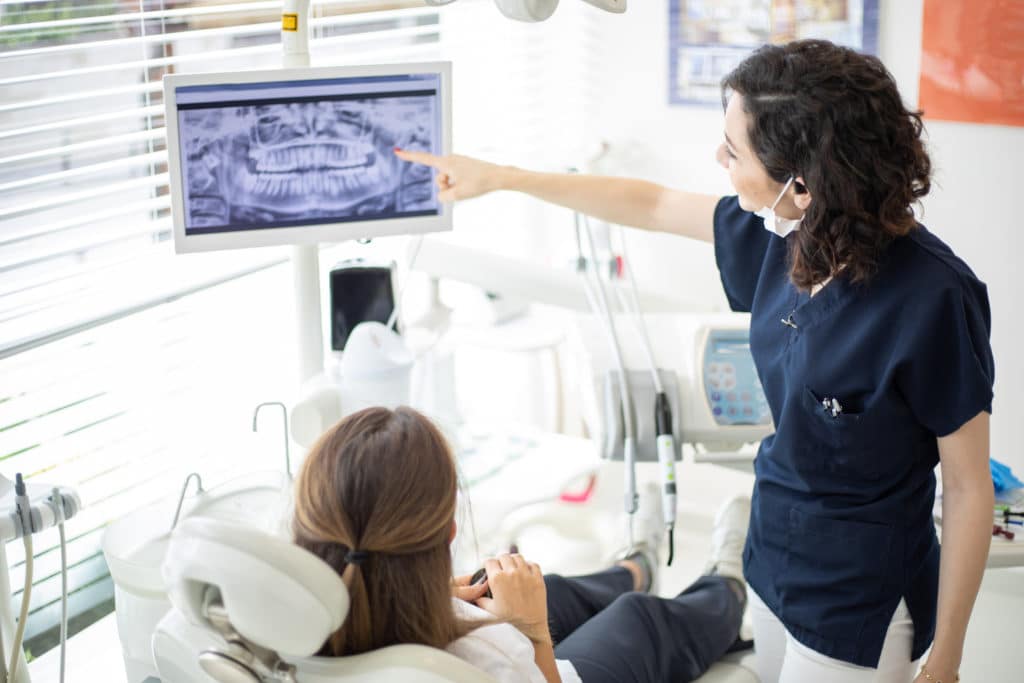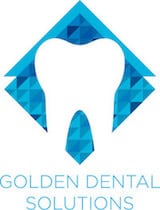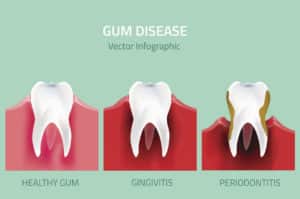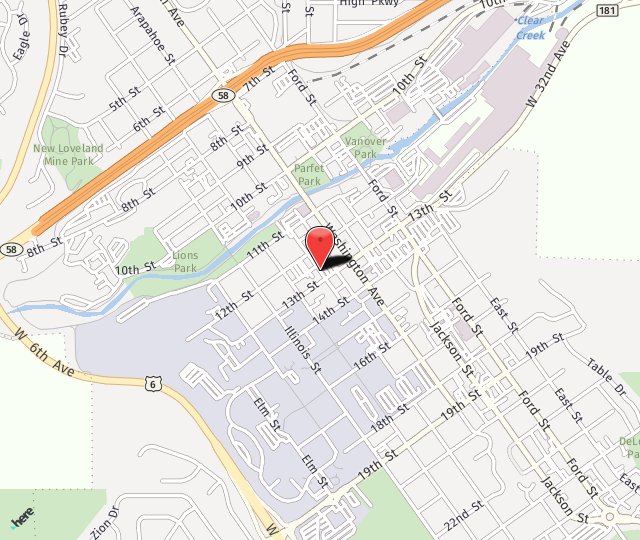Gum Disease Treatment in Golden, CO
People can assume that gum disease is a disease that can be contracted, like measles or hepatitis. Truth is, gum disease is invariably self-caused, usually due to poor dental hygiene and some other personal habits such as smoking. But that’s also a good thing, because early signs of gum disease can clue you in that you need to pay more attention to your oral health, and then your progression towards full-blown periodontitis can be reversed.
Our team is with you every step of the way, from twice-yearly cleanings and exams to keep your hygiene in good shape to laser gum scaling and planning and cleaning of periodontal pockets with gum disease.
Here’s what you need to know about gum disease.
Schedule Your Consultation Today!
What is Gum Disease?
You don’t wake up one morning and have gum disease; you see signs as your oral health worsens. First comes gingivitis. This is a big word that simply means gum irritation. Plaque is the sticky film that forms on your teeth throughout the day. When you brush and floss you remove the plaque, only for it to begin forming immediately again. This back and forth is why you need to brush twice daily, to keep plaque at bay. But when it builds up on your teeth it causes your gums to become inflamed. They become red and bleed easily when you’re brushing. At this point, your gums are simply irritated and they’re holding your teeth firmly in place.
But if you let gingivitis progress, the plaque begins to build and move under your gums. This makes the gums begin to pull away from the teeth and form pockets. Now you’re entering full-blown gum disease, clinically known as periodontitis. As bacteria build up in these pockets, it starts to break down the bone and connective tissue that hold your teeth in place. Pockets deepen and more gum tissue and bone are destroyed. Your teeth begin to loosen and fall out. The end of gum disease is a mouth without any teeth.
What Causes Periodontal Disease?
Plaque is the main cause of gum disease. It is innocent enough as it builds on your teeth, and you simply brush and floss it away. When it is left alone and it starts to build under your gumline, that’s when problems begin. Poor oral hygiene at home and lack of professional exams and cleanings are far and away from the main cause of gum disease. This is a shame because it is so preventable.
There are some other factors that can contribute to a person developing gum disease: hormonal changes during pregnancy and menopause can make your gums more sensitive; certain illnesses such as HIV and diabetes can limit your body’s immune response; some medications reduce saliva flow, and habits such as smoking can make it harder for the gums to repair damaged tissue.
What does periodontal disease look like
The first stage of periodontal disease is gingivitis. This stage may not offer any clues. Patients should be very aware of increased instances of bad breath, bleeding during oral care, and redness or swelling in the gums. These symptoms are usually so mild that they go unnoticed.
Slight periodontal disease presents as swelling and redness in the gums. The gums may bleed when brushing or flossing. The patient often experiences bad breath. Probing depths are between four and five millimeters
Moderate periodontal disease presents with the same symptoms as slight periodontal disease but probing depths are six to seven millimeters. This depth allows for even more bacteria to attack, not only the jawbone but also the bloodstream and immune system.
Advanced periodontal disease causes redness and swelling in the gums. The gums may ooze pus. Teeth may be sensitive to cold and may feel loose or painful when chewing. Patients with advanced periodontal disease typically have severe halitosis.
Can periodontitis cause other health problems?
Yes. Periodontitis results from an overgrowth of harmful bacteria in the gums and underlying bone. The bacteria that thrive in the mouth can travel through the bloodstream to adversely affect other parts of the body. The presence of periodontal disease increases concerns for elevated risks of:
- Alzheimer’s Disease and dementia
- Respiratory conditions such as COPD
- Cardiovascular disease
- Diabetes
- Pregnancy complications
- Kidney disease
- Erectile dysfunction
- Rheumatoid arthritis
Are There Different Types of Gum Disease?
This depends on if you consider gingivitis to be gum disease or a precursor. You can break gum disease into different types depending on how it has progressed.
- Gingivitis — This is early gum disease. Basically, it simply means that plaque is beginning to irritate the gums, making them red and prone to bleeding.
- Chronic periodontitis — Gums have pulled away from the teeth and formed pockets where bacteria are accumulating. Periodontitis always starts with gingivitis. Now the bacteria will begin attacking the bone and tissues attaching the teeth to the jawbone.
- Periodontal abscess —This happens when a pocket forms and becomes infected to the degree that an abscess forms. This will lead to the quick destruction of the attaching tissues of the teeth in the area.
- Perio-endo lesion —This occurs when the infection begins in the tooth root. When decay enters a tooth, if not removed, it can eventually impact the pulp and the nerves and blood vessels within the pulp. This infection moves from the tooth into the surrounding gums.
- Gingival recession — This isn’t always due to plaque buildup. Overly aggressive tooth brushing can also cause this recession. The gums recede, exposing the tooth root that is normally covered by the gums.
What Are The Symptoms of Periodontitis?
As noted above, gum disease doesn’t simply happen — there will be signs. These are the symptoms:
- Gums that bleed when brushing your teeth
- Red, swollen, tender gums
- Persistent bad breath
- Bad taste in the mouth
- Receding gums
- Deep pockets between the teeth and the gums
- Loose or shifting teeth
- Changes in bite

Is periodontitis reversible?
The only stage of periodontal disease that is reversible is gingivitis. At this stage, the infection has not begun to affect underlying bone tissue. It is limited to the formation of plaque and tartar on teeth, and offers few signs of an impending problem. When caught early, gingivitis may be corrected with a professional cleaning followed by good oral hygiene at home.
How do our doctors diagnose gum disease?
First, you need to keep up with your twice-yearly professional cleanings and exams with our doctors. That is when we can spot your progressing gum disease and reverse it.
Here’s what we check:
- Gum condition — We look for bleeding, swelling, and check the firmness of your gums. We measure the pockets (the space between the gums and teeth)
- Movement — We look for any movement and change in your alignment by comparing x-rays for progression. We check for tooth sensitivity.
- Jawbone mass — We look for any breakdown of the jawbone where your teeth are anchored.
Schedule Your Consultation Today!
Can Periodontitis be stopped?
All forms of periodontitis require professional dental care. The earlier that treatment is administered, the better gum health can be managed nonsurgically. Once a person has moderate periodontitis that has worsened from gingivitis, they will require ongoing management for the rest of their life. With appropriate care and daily hygiene practices infection may go into remission. However, patients should be consistent with the following:
- Brushing twice a day for two full minutes each time.
- Daily flossing.
- Eating a healthy diet low in refined carbs and sugar.
- Avoid smoking and using tobacco products.
- Minimize alcohol consumption.
- Maintain routine dental checkups and cleanings.
How long does it take to cure Periodontal Disease
Periodontal disease cannot be cured. Patients must maintain visits with their dentist at least twice a year to keep their gum health under control. With routine professional checkups and cleanings and daily hygiene, many people with periodontal disease are able to prevent the worsening of infection.
How is gum disease treated?
The treatment we use depends, of course, on the severity of your gum disease. The goal is first to stop the progression. We need to remove the infection and get the gums to begin to reattach to the teeth. Treatments can be both surgical and non-surgical. Our doctors can perform many of these procedures, or they may recommend a periodontist for more involved needs.
Non-Surgical Treatments Include:
Perio-Protect
The Perio Tray by Perio Protect gently applies medication deep under the gums to fight the infections. You use it at home for just minutes each day. The Tray is comfortable, flexible, and custom-fit precisely for your mouth.
Root scaling and planing
Done under local anesthesia, we use our diode laser to remove plaque and tartar from below the gumline. This is called scaling. We then make the surface smooth so that the gums can reattach. This is called scaling.
Surgical treatments Include:
Flap surgery/pocket reduction surgery
In this procedure, the gums are lifted back and the tartar is removed. We use our laser to clean periodontal pockets, vaporizing infected tissue, and disinfecting the area to activate tissue regrowth. The laser energy penetrates the soft tissues while instantly sealing blood vessels and nerve endings.
Bone grafts
Bone grafts are used on areas of the jawbone that have deteriorated. The grafts are placed and bone mass regrows, stabilizing the teeth.
Soft tissue grafts
The tissue is usually taken from the roof of the mouth and stitched onto areas where the gums have receded or thinned.
Bone surgery
In moderate to advanced jawbone loss, surgery is done to decrease craters that have formed.
Drug treatments Include:
Antibiotics For Gum Disease
Antibiotics will usually be included with other gum disease treatments. These are needed to reduce or eliminate the bacteria in the gum pockets or causing jawbone destruction. There are also antimicrobial rinses and antibiotic toothpaste that may be used.
What Our Patients Have to Say
“I’ve had Dr. Kenson at different times and each one is as great as the other. All the hygienists are caring and very skilled and the front office staff are exceptionally nice!” -Jim W.
Laser Dentistry for Periodontal Disease
At our office in Golden, CO we utilize the latest in laser technology to clean out the periodontal pocket and restore your gums. Laser dentistry is typically used in conjunction with scaling and root planing but can be used in any case where the gums are bleeding.
Can gum disease be reversed?
Gum disease can almost always be reversed. It’s a matter of reducing the pockets, removing the infection, restoring the bone (if necessary), and getting the gums to reattach to the teeth. Of course, how far the gum disease has progressed can dictate if the reversal is possible. For instance, if a person has allowed the disease to progress to the point where all of his or her teeth are affected and cannot be saved, extraction may be necessary and the teeth replaced by dentures or dental implants.
What can I do to prevent gum disease?
Unlike diseases that you simply acquire, this one is easy — take care of your home oral hygiene and keep your twice-yearly professional cleanings and exams with our doctors. If you do this, the odds of developing gum disease are very low.
Is periodontitis treatment covered by insurance?
Most insurance companies provide some degree of coverage for gum treatments. This can vary by plan, so patients are encouraged to contact their dental insurance provider for specific information regarding their coverage.
Schedule a Consultation
If you are interested in gum disease treatment and would like to see if you are a good candidate, call (303) 277-9600 to schedule a consultation. Our practice serves patients from Denver, Golden, and surrounding areas.

Our Office Would Love to Hear From You!
If you have any questions about the services we offer or would like to schedule an appointment, please call us today at (303) 277-9600

 5 Stars from over 200 reviews!
5 Stars from over 200 reviews! 


